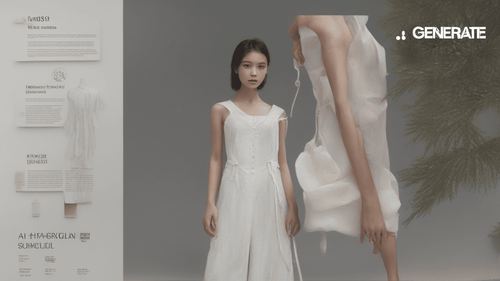
Introduction: Embracing Artistic Evolution through AI
In an era marked by technological advancement, the realms of art and creativity are undergoing a revolutionary transformation. Thanks to the rapid development of Artificial Intelligence (AI), the seemingly distinct domains of language and art are now intertwined in ways that were once unimaginable. The concept of "Generate AI Art from Text" has emerged as a captivating blend of linguistic expression and visual aesthetics, offering artists and enthusiasts a gateway to new dimensions of creativity.
The Intersection of AI and Art: A Paradigm Shift
Unleashing AI's Creative Potential
AI, once primarily associated with data analysis and automation, has blossomed into a tool of artistic expression. Through sophisticated algorithms and machine learning techniques, AI can translate textual prompts into stunning visual masterpieces. This synergy between AI and art has given birth to a transformative process - the ability to generate AI art from text, redefining artistic boundaries.
The Birth of Picasso AI
Enter Picasso AI, a pioneering platform that harnesses the power of AI to create art from textual cues. Named after the legendary artist Pablo Picasso, this platform embodies his spirit of innovation and reimagining artistic norms. Through Picasso AI, users can provide simple textual descriptions, and the AI interprets and transforms these words into visually captivating artworks that often transcend human imagination.
Understanding the Mechanics of AI Art Generation
From Textual Input to Visual Output: The Journey Unveiled
The process of generating AI art from text is a symphony of complex algorithms and neural networks. As a user submits a text prompt to Picasso AI, the platform employs Natural Language Processing (NLP) techniques to decode the essence of the input. This linguistic understanding is then seamlessly blended with image-generation algorithms, resulting in an artwork that encapsulates the textual inspiration.
Variety in Styles: A Palette of Possibilities
Picasso AI boasts a repertoire of artistic styles, from Impressionism to Cubism, ensuring that the generated artworks are diverse and captivating. By considering the nuances of the input text, the AI adapts its artistic approach, creating an array of visuals that mirror the textual emotions or concepts.
The Fusion of Language and Aesthetics: A Paradigm of Innovation
Democratizing Artistry: AI as an Inclusive Tool
One of the remarkable aspects of generating AI art from text is its democratizing effect on artistic creation. Traditionally, artistry was limited by skill and resources, but with AI's intervention, anyone with a creative spark can see their visions materialize in vivid visuals. This inclusive approach reshapes the art landscape, celebrating diversity and expanding the boundaries of creativity.
An Inspiring Symbiosis: AI as a Collaborative Partner
AI's role in artistic creation is not about replacing human ingenuity but rather enhancing it. Through the generate AI art from text process, artists and AI engage in a symbiotic partnership, where human creativity is amplified by AI's ability to rapidly iterate and experiment. This collaborative dance between human and machine transcends conventional artistic paradigms.
FAQs: Demystifying the Realm of AI-Generated Art
Is the AI completely replacing human artists?
AI is not here to replace human artists, but to complement and augment their creativity. It serves as a tool that amplifies artistic potential, encouraging innovative collaboration.
Can AI-generated art evoke genuine emotions?
Yes, AI-generated art has the potential to evoke genuine emotions, as it draws inspiration from textual cues that often carry emotional significance.
How does AI ensure artistic diversity?
AI achieves diversity by adapting its artistic style based on the nuances of the input text, resulting in a wide range of visual interpretations.
Do artists need technical expertise to use Picasso AI?
No, Picasso AI is designed to be user-friendly, allowing artists of all backgrounds to effortlessly translate their ideas into visual art.
What impact does AI art have on the traditional art world?
AI art adds a layer of innovation and challenges traditional norms, inviting discussions about creativity, authorship, and the evolving definition of art.
Can AI-generated art be considered original?
AI-generated art is undoubtedly original, as it stems from a unique interplay of textual inspiration, AI algorithms, and artistic interpretation.
Conclusion: A Canvas of Infinite Potential
In a world where AI's capabilities continue to astound, the fusion of generate AI art from text represents a captivating paradigm shift in the realm of creativity. Picasso AI's ability to transform words into visuals exemplifies the harmonious partnership between human ingenuity and technological innovation. As we embark on this artistic journey guided by AI's brushstrokes, we find ourselves on a canvas of infinite potential, where imagination knows no bounds and art takes on a whole new dimension.
The evolution of AI-generated art reminds us that innovation knows no limits, and it is our willingness to explore the uncharted territories of creativity that propels us into a future where the boundaries between human expression and technological marvels continue to blur. So, dare to dream, dare to describe, and watch in awe as AI brings your words to life on a canvas that defies convention and embraces the extraordinary.
As the digital and artistic landscapes intertwine, the phrase "generate AI art from text" becomes a beacon of artistic discovery, leading us to explore the uncharted territories of imagination. With each stroke of AI-generated genius, we inch closer to a world where creativity blooms anew, driven by the powerful synergy of words and visuals.
Learn more about Picasso AI and witness the evolution of creativity that bridges the gap between language and art.